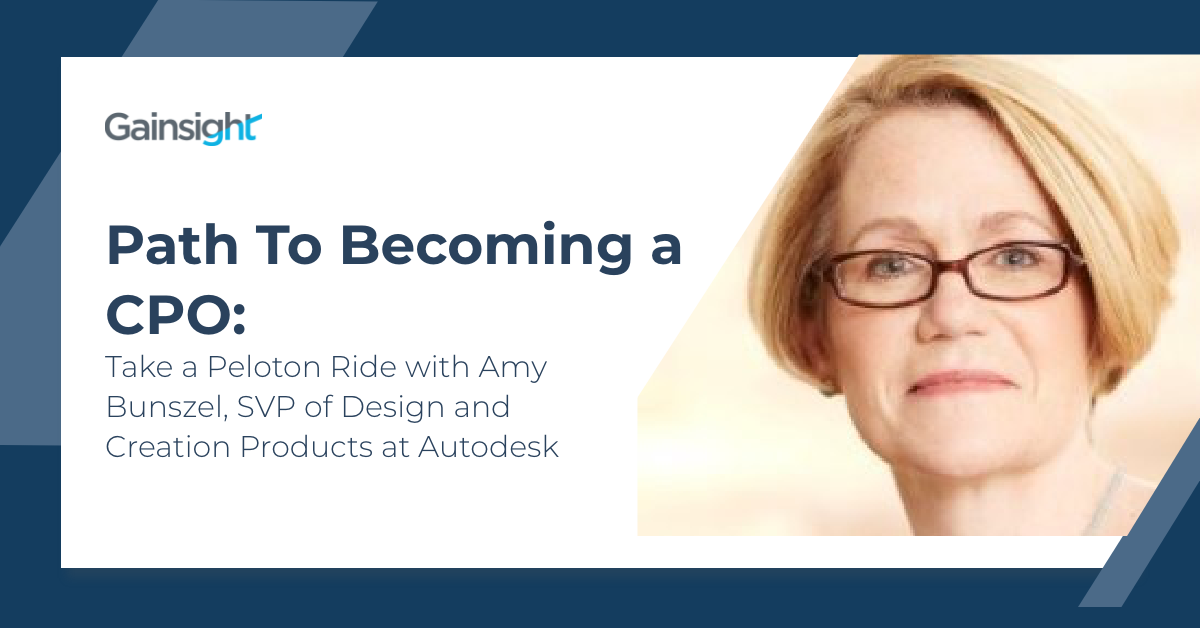Each month, Gainsight is hosting a product leader in this new series “Path to Becoming a CPO.” We will share the lessons here but also encourage you to sign up for the live webinar series here.
Some of you may have heard of the Peloton Cycle. It is a stationary bike system built with a large screen at the front, enabling users to live stream or follow on-demand workouts at home. The spin-cycle classes offer a variety of lengths and intensity levels. Don’t worry, this is not an article about the exer-bike or the “push button health” craze. Instead, it is about what Amy Bunszel, Senior Vice President of Design and Creation Products at Autodesk, learned from the subscription portion of the at-home fitness programs offered by Peloton.
A Journey of Discovery
Amy’s journey is one that should be studied by anyone seeking guidance in their career and life. It is a genuinely worthy lesson about willingness to learn, the ability to adapt successfully, the power of motivating team leadership, the benefits of making data-driven decisions from product usage insights, and the results produced from commitment. Amy started as a hardware engineer. She is an electrical engineer by education, and her first job was at G.E. working on radar systems. As Amy began her career journey, she changed jobs about every two years, sometimes intentionally, sometimes not. None of her employment at that time was about product management.
What Amy discovered in the process of changing jobs was—herself. She learned more about what she wanted to do for a living and where her passion was. In a recent webinar with Denise Stokowski, Group VP of Platform Products at Gainsight, Amy shared that she identified that she wanted to be more involved with people. “I liked synthesizing concepts. I liked being that interface between what the company was building and what the customer needs.” Amy also believes that with each job, she moved closer to software and began thinking about product management. She also realized she had a gift for resilience.
The process of finding her career path took a while. Amy said, “When I look back on it, it was quite the journey. You know, I’ve been laid off. I’ve worked for companies that shut down. I once had a manager who told me that I should just get a job somewhere else. So, there were quite a lot of things that happened along the way. But having the resilience to manage all that was really important in the early days of my career.”
Resilience Equals Love of Challenges
Her resilience translates into a love of challenges. In 1996, Amy started her own business that was later acquired by Autodesk in 2003. At Autodesk, she began as an individual contributor, product manager. She enjoyed the startup environment even though she was performing “a thousand different jobs.” At Autodesk, Amy found the ability to develop as a professional product manager and expanded her skill set.
Mirroring her diverse early career experience, Amy did not waste the opportunity to learn from people and new experiences. “I moved up the ranks, managing product managers, expanding the team to cover more products,” Amy shared. “And then for me, a key point was when I took on cross-functional responsibility. So I went from running product to running product and development.” Amy said that the challenge was fun because she had to manage many people that were in jobs she had never done before. That caused a pivot in her mindset. “I had to think about leadership differently,” Amy stated. “More about empowering people than it was about knowing how to do their work.”
Amy discovered again that every couple of years, her assignment and responsibilities changed. Eventually, she moved to San Francisco about ten years ago. Amy took a role as vice president of the AutoCAD team, changing product lines and changing divisions within Autodesk. That proved to Amy that she was a multi-dimensional leader. She could adapt to different types of products and various kinds of phases, and it put her on a path to get additional responsibility over time, Not soon after, Amy became senior vice president of Digital Engineering Products. It was about that same time that Autodesk started moving from serial numbers and perpetual licenses to subscription and name users. That may have been when she faced her most significant challenge.
Never Waste a Metaphor
Amy Bunszel believes in the phrase, “never waste a metaphor.” And as stated, she is also a fan of the Peloton cycle. What is interesting about this piece of equipment is that it is a virtual workout with real-world results. You don’t have to haul yourself down to your local gym. You can work out in the “comfort” of your own home. What is also curious about Peloton is that it is a lesson in product experience and SaaS. Amy Bunszel loves a challenge, as evidenced by her gold status on Peloton. Denise Stokowski connected this workout achievement to her next perplexing problem.
During the webinar, both Amy and Denise wore Peloton shirts, which subscribers receive after their 100th workout. Denise asked, “What does this Peloton thing have to do with product management?” That is when Amy explained how she brought a consumer product mindset to Autodesk’s product and development organization to combat their limited vision of customer experience.
“I had a hard time getting our development organization and all the product and user experience people to understand what kind of mindset shift they had to make to start thinking about people logging into our software every day. What kind of experience we should deliver.”
This issue is not uncommon as more and more companies face digital transformation and a subscription services market. Amy engaged all of her past experiences, her learning from the many people she worked with to find a common metaphor that could speak to everyone. At an annual Autodesk engineering technical conference two years ago, Amy took the stage to address this very issue wearing a Peloton shirt and told the audience the story of the Peloton subscription experience.
The Peloton Experience
Peloton began in 2012 by former Barnes & Noble e-commerce executive John Foley with the idea of in-home fitness classes. By the end of the fiscal year 2019, the company had over 500,000 subscribers, rare brick and mortar sales, a reliance on referrals, and annual subscription revenue of $181M, and total revenue of $915M.
Now, this company has had more ups and downs than riders in a spin-cycle class. There was a significant investment in marketing and monumental revenue loss after its IPO in September 2019. But Peloton has come back, especially in the time of COVID-19, with 2020 third-quarter earnings of $524.6M (Peloton Q3 2020). The company expects full year-end revenue of $1.72BN and subscribers to double. They also have a mind-blowing Average Net Monthly Connected Fitness Churn of 0.46% and a 12-month retention rate of 93%. All this despite the base model bike pricing over $2000 and varying subscription level models.
Don’t kid yourself. This company’s success is about an experience created by a product and analytics the company dials into to reach each of its subscribers. That nuance was not lost on Amy Bunszel. As a Product executive, there is a balance in focus that one must have. In Amy’s over 16 years of experience at Autodesk, she has seen changes in the world of products, and she explained how some skills needed to be a part of the product framework and leadership.
Lessons Learned in Product Leadership
Amy advised leaders to have a skill of prudent vision regarding resources, both monetary and human capital. Sometimes there is an emphasis on speed in rolling out new products or features. For Amy, she has found out that it is better to lean into agility and take diligent steps to see if projects are actually a good and profitable idea. She saw this had two effects on her team and process.
The first agility effect is on your resources budget. In the past, Amy saw projects grow too fast, with too many people and resources “thrown” at them. “We put 100 people on it, and nobody knew what they should be doing because it was too early to put that many resources on it.” She advised discretion in using up assets, adding more as products prove out specific hypotheses or hit milestones. It saves the embarrassment of overusing resources in the beginning or all at once. It also helps with the morale of a team. Hitting milestones reinvigorates the team and helps them continue in the planned direction.
Another effect of leaning into agility, Amy found the ability to have more frequent customer engagements and releases.”That was a significant mind shift change.” Amy said. Before there was a dependence on having a “marching” plan for six months, nine months, or a year. Instead, they responded to product development and had quicker cycles. It helped them to be more responsive to customers and created a better experiential relationship with them and around the product.
A second skill that Amy discovered in product leadership was to be decisive and keep product teams moving. She conveyed that as you go up the ranks in leadership, it’s essential to empower the decision-makers below you. “While you might have excellent decision-making skills, you kind of need to pass that torch over to the people who are reporting to you and help them develop those skills and empower them to make decisions.” She realized that as you rise in the chain of command, you’re still making all of the critical decisions. But if you do not allow others to make decisions, you will lose momentum as an organization. “You need to find a way to trust what’s going on in the team below you,” she said. “Empower them to make decisions and help them learn when you know something doesn’t go as expected.”
Overcoming Fear of Failure
Frankly, things don’t always go as expected, and without a strong belief that your leadership trusts you, there can be a fear of failure. However, Amy said that “If you’re not taking some kind of risk, then you’re not going to be learning as much as you can.” As a leader, Amy emphasized using yourself as an example and sharing your own story with an individual or team when something wrong happens. That is where her experience with Peloton came in.
Amy explained in the webinar how she related her revelation to her peers and employees. After telling the Peloton story, Amy mapped out what she hoped someday would be the Autodesk subscription experience. She realized that there was a level of skepticism and fear in her team’s inability to pivot their mindset surrounding product experience. In a 20 minute presentation, Amy leveraged the story and the metaphor of how Peloton did a great job personalizing the subscriber experience based on data and analytics.
Years ago, much of product management’s knowledge came from what the competitors were doing. It was not uncommon to go on customer visits or run surveys. Decisions were sometimes based on instinct. Now, product teams can unify that with mountains of usage, sentiment, and churn data, all of which can be measured using Gainsight PX. Amy explained that a product manager can “look across a much broader landscape, marry quantitative and qualitative things together to come up with decisions.” She admitted that there is still a challenge to make decisions quickly so you can keep organizations moving. “However, building that data muscle and having to go to people in your organization who can help sift through all that data is important.” According to Amy, PX helps you make decisions about where to go with the product, and you can start building out those personalized experiences for users.
“I do think that’s part of what I love about the Peloton [metaphor], is that they’ve got quite the data engine going there,” Amy admitted that when she gets her monthly Peloton report of activity, she wishes she could send the same kind of information to her users, end to end, to add value. She added, “On top of that, maybe with suggestions of how they compare against other users of our software, where they might want to invest and learn new things. There’s a huge opportunity for us going forward there.” The Peloton metaphor continues to have an effect on her audience from that gathering. Amy shared that two years later, people are still talking about how that metaphor helped them understand the mindset change they had to make. She also received a few referrals for Peloton from it.
PX as a Human First Tool
Towards the end of the webinar, Denise and Amy answered a question regarding their “go-to” tools. Both explained that PX is an indispensable part of their toolkits for gathering data and insights. Denise discussed how it focuses on where customers are going within a product. It also highlights what actions make users more efficient. Customers are appreciative of that type of feedback. Amy agreed that they also rely on usage data and dashboards. She shared that it was interesting to watch the impact of the COVID-19 pandemic on customers worldwide through the lens of PX.
As people were sent to work from home, Amy and her team could see a dip in usage, but then they also saw recovery. “We were able not to overreact or guess what was happening to them and their ability to use our products from home. We could see it happening right then and there. We were then able to focus on how to help them be more effective because we knew they were up and running.” PX enabled her organization to reach out to do their best work. Even though PX is about data, analytics, and experience, it would not work without a human first viewpoint tied to it. The customers using your product are, after all, human beings first.
Both Denise and Amy tied it together that the human element is an integral part of their toolkits. For Denise, she shared that it can be found in talking to a customer to understand what they are trying to accomplish and why. Amy agreed and added some additional advice. “One piece of advice I got early on as a product manager was to have a couple of “go-to” people in different organizations, let’s say on the sales team, who you trust, and you can bounce ideas off of.” She did not limit her circle of trust just within her company. Amy suggested people in channel organizations, trusted resellers of products, and even some customers. With a wide range of people, you can develop a firm grasp of different experiences.
So there are some morals to this story. One, never lose the opportunity to learn something, especially about yourself. Two, don’t get discouraged if you don’t find your right job fit for a while. Three, never waste a good metaphor if you have one and get what you can out of it. Four, always remember that even in Product use, management, and leadership, there is the element of human first. And, of course, with the help of Gainsight PX, you can accomplish all of these things.


